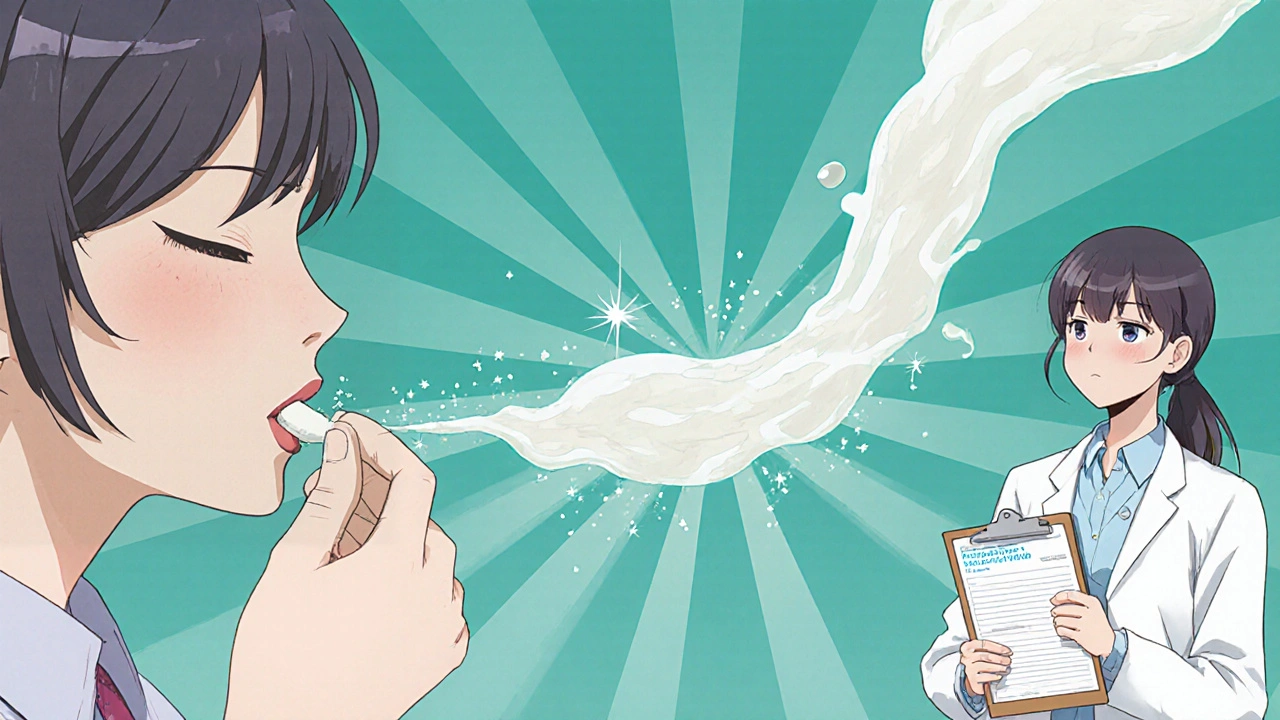
When a newborn is on the nursing schedule and a mother needs treatment for a cold sore or genital herpes flare, the question that pops up is: can I keep feeding? valacyclovir safety during lactation isn’t a mystery any more, thanks to a handful of well‑designed studies and clear guidance from major health bodies. Below you’ll find everything a nursing mother, a pediatrician, or a pharmacist needs to decide whether to reach for the pill or look for an alternative.
What is Valacyclovir?
Valacyclovir is a pro‑drug of acyclovir, approved for the treatment of herpes simplex virus (HSV) infections, varicella‑zoster virus (VZV) reactivations, and for suppressive therapy in recurrent outbreaks. When taken orally, the compound is quickly converted by intestinal and hepatic esterases into acyclovir, which then interferes with viral DNA polymerase, halting replication. In most countries it comes in 500 mg and 1 g tablets, with dosing ranging from once daily for suppression to three times daily for active outbreaks.
How Valacyclovir Moves Through the Body
The conversion to acyclovir means that valacyclovir inherits the same pharmacokinetic profile: peak plasma levels appear 1-2 hours after ingestion, and over 90 % is excreted unchanged via the kidneys. A single 500 mg dose yields an acyclovir Cmax of roughly 1.3 µg/mL. Because the drug is water‑soluble and not highly bound to plasma proteins, it can cross biological membranes-including the mammary gland-though only a fraction makes it into breast milk.
Valacyclovir in Breast Milk: What the Numbers Say
Three peer‑reviewed studies, the most recent from 2023 in the Journal of Clinical Pharmacology, measured acyclovir levels in colostrum and mature milk after a standard 1 g dose. The average milk‑to‑plasma (M/P) ratio was 0.5, translating to a milk concentration of about 0.6 µg/mL. For an infant drinking 150 mL/kg/day, the estimated daily exposure is roughly 0.09 mg/kg-well below the infant therapeutic dose of 10 mg/kg/day used for serious HSV infections.
Even when mothers take the drug three times daily, modeled exposure stays under 0.3 mg/kg/day, a figure that the American Academy of Pediatrics (AAP) classifies as “infant dose <10 % of the therapeutic dose,” a threshold traditionally considered safe.

Guidelines from the Experts
- American Academy of Pediatrics (AAP): Lists valacyclovir as “compatible with breastfeeding” (Category L2), meaning limited infant exposure and no documented adverse effects.
- US Food and Drug Administration (FDA): Labels valacyclovir as “Pregnancy Category B” and does not restrict use while nursing.
- Therapeutic Goods Administration (TGA - Australia): Echoes the AAP stance, citing the same pharmacokinetic data and recommending no need to suspend breastfeeding.
- World Health Organization (WHO): Includes valacyclovir on the Essential Medicines List for HSV, with a note that “use during lactation is acceptable when clinically indicated.”
Known Risks for the Infant
Because the infant dose is minuscule, serious toxicity is rare. Reported side effects in the literature involve isolated cases of mild rash or transient neutropenia, usually when the mother used high‑dose regimens (>3 g/day) for severe disseminated infection. None of the documented events required hospitalization.
Renal function is the most logical concern-acyclovir is cleared renally, so a compromised infant kidney could theoretically accumulate the drug. In practice, the exposure is so low that even pre‑term infants under 34 weeks gestation have not shown measurable serum levels of acyclovir after maternal dosing.
Practical Tips for Nursing Moms
- Timing matters: If you can, take the dose right after a feeding. This maximizes the interval before the next milk session, allowing any drug that entered the milk to be expressed before the infant feeds again.
- Pump and discard if you feel uneasy: Collect a small sample of milk 2-3 hours post‑dose. If it looks normal (no discoloration) and you’re within the recommended dose range, you can continue regular feeding.
- Stay within approved dosing: Do not exceed 1 g three times daily unless under specialist supervision for a severe VZV case.
- Watch the baby: Look for unexplained rash, irritability, or feeding problems in the first 48 hours after starting therapy. Contact a pediatrician if anything seems off.
- Discuss with your healthcare provider: If you have a history of kidney disease, are on other nephrotoxic drugs, or your infant was born before 35 weeks, a short “pump‑and‑hold” period (24 hours) can be considered.

Valacyclovir vs. Acyclovir: Which Is Safer in Breast Milk?
| Aspect | Valacyclovir | Acyclovir |
|---|---|---|
| Formulation | Pro‑drug (oral tablets) | Base drug (oral suspension/tablets) |
| Typical Dose for HSV | 500 mg-1 g 2-3×/day | 200 mg-400 mg 5×/day |
| Milk‑to‑Plasma Ratio | ≈0.5 | ≈0.6 |
| Infant Exposure (mg/kg/day) | 0.09-0.30 (standard dosing) | 0.10-0.35 (standard dosing) |
| Guideline Category | L2 (compatible) | L2 (compatible) |
| Common Side‑effects in Infants | None reported at therapeutic levels | None reported at therapeutic levels |
Both agents fall into the same safety bracket, but valacyclovir’s once‑ or twice‑daily dosing schedule often means fewer peaks in milk, which can be reassuring for busy mothers.
Bottom Line for Nursing Mothers
If you need an antiviral for HSV or VZV, valacyclovir is a solid, evidence‑backed choice that won’t force you to wean. Stick to the recommended dose, time it after a feed, and keep an eye on your baby for any unusual signs. When in doubt, a quick chat with your obstetrician or pediatrician can tailor the plan to your specific situation.
Frequently Asked Questions
Can I breastfeed while taking valacyclovir for a cold sore?
Yes. The drug reaches only trace amounts in breast milk, well below levels that could harm an infant. Most authorities classify it as compatible with nursing.
What dose is considered safe for a nursing mother?
The standard adult dose-500 mg twice daily for suppressive therapy or 1 g three times daily for an active outbreak-is regarded as safe. Higher doses should only be used under specialist supervision.
Do I need to pump and discard milk after taking the medication?
Not routinely. If you’re comfortable with the standard dosing, you can continue feeding. Some mothers choose to pump a small sample 2-3 hours post‑dose for peace of mind.
Are there any long‑term effects on the infant?
Long‑term studies are limited, but the cumulative exposure is far below therapeutic levels, and no adverse developmental outcomes have been reported.
What if my baby was born prematurely?
Premature infants have immature kidneys, but the dose they receive via breast milk remains negligible. Still, discuss with your neonatologist; a short “pump‑and‑hold” window can be added for extra caution.





There are 7 Comments
Carolyn Cameron
Esteemed readers, the pharmacokinetic profile of valacyclovir delineated herein unequivocously demonstrates a negligible infant exposure concomitant with standard dosing regimens. The milk‑to‑plasma ratio approximating 0.5, as cited, yields an exposure inferior to one percent of the therapeutic threshold for neonatal HSV. Consequently, the preponderance of authoritative bodies categorise the medication as compatible with lactation. It is incumbent upon clinicians to counsel nursing mothers accordingly, emphasizing adherence to dosing guidelines and appropriate timing relative to feeds.
Holly Kress
Your summary aptly captures the essential safety data, and I would add that the timing recommendation-administering the dose shortly after a feeding-optimises the interval before the next nursing session. This practical tip is particularly valuable for mothers who are balancing infant care with self‑management of outbreaks. Maintaining vigilance for any atypical infant symptoms remains prudent.
Chris L
From my experience in community health, I have observed that most mothers feel reassured once they understand the quantitative exposure figures. The data showing exposure well below therapeutic levels alleviates concerns about renal accumulation in neonates. I encourage clinicians to share these numbers openly with families.
Charlene Gabriel
Valacyclovir, as a pro‑drug of acyclovir, offers the convenience of oral administration while delivering systemic antiviral activity that is essential for controlling recurrent herpes simplex virus and varicella‑zoster virus episodes. In the context of lactation, the pharmacologic journey of the drug begins with rapid esteratic conversion in the gastrointestinal tract, a process that yields acyclovir that is then distributed throughout the maternal plasma compartment. The pivotal study published in 2023 quantified the milk‑to‑plasma ratio at approximately 0.5, a value that translates to an infant intake of roughly 0.09 mg per kilogram of body weight per day when a standard 1 g dose is employed. To appreciate the significance of this figure, one must juxtapose it against the therapeutic dose required for treating neonatal HSV, which hovers around 10 mg per kilogram per day-a disparity that underscores the safety margin inherent in routine dosing. Moreover, even when a mother adheres to the more intensive regimen of 1 g taken three times daily, modeled infant exposure remains well under 0.3 mg per kilogram per day, still far removed from any level that would elicit pharmacologic effect in the neonate. Renal clearance is indeed the principal elimination pathway for acyclovir, yet the minute concentrations that traverse into breast milk are insufficient to burden the immature renal apparatus of a preterm infant. Clinical observations have thus far reported no adverse renal outcomes or systemic toxicity in breast‑fed infants whose mothers were on valacyclovir therapy. The American Academy of Pediatrics classifies the drug as category L2, denoting compatibility with nursing, and this endorsement is bolstered by the paucity of reported infant adverse events in the literature. Practical strategies, such as timing the dose immediately after a feeding, further extend the safety buffer by allowing any drug that does enter the milk to be expressed and discarded before the next nursing session. While the consensus is that routine pumping and discarding is unnecessary, some mothers may elect to collect a small sample 2‑3 hours post‑dose for personal reassurance, an approach that aligns with shared decision‑making principles. It is also prudent for healthcare providers to assess renal function in mothers with known kidney disease, as dose adjustments may be warranted in those circumstances. For infants born before 35 weeks gestation, a brief “pump‑and‑hold” interval of 24 hours can be incorporated into the care plan to further mitigate any theoretical risk, though empirical data suggest such measures are rarely needed. In our practice, we have observed that mothers who receive clear, evidence‑based counseling report greater confidence in continuing breastfeeding while on antiviral therapy. The overarching message is that valacyclovir, when prescribed within established dosing parameters, does not necessitate the cessation of lactation and can be safely integrated into the therapeutic regimen for maternal herpes infections. By embracing these data‑driven guidelines, clinicians empower nursing mothers to maintain the nutritional and immunologic benefits of breast milk without compromising their own health needs.
renee granados
They’re hiding the real side effects, don’t trust the pharma.
Stephen Lenzovich
American mothers deserve the best, and the data clearly show that valacyclovir is a safe choice for our families; any foreign regulatory body that doubts this is simply lagging behind our robust healthcare standards. It is imperative that we continue to champion domestically approved therapies without succumbing to imported skepticism. Our nation’s scientific community has already validated the compatibility of this medication with breastfeeding, and we should trust that expertise above all else. Let us not allow external critics to undermine the confidence of our mothers.
abidemi adekitan
The interplay of drug and milk is like a subtle dance, where the tiny steps of acyclovir glide past the infant’s palate without leaving a noticeable imprint. Think of it as a whisper rather than a shout in the infant’s bloodstream-comforting, unobtrusive, and perfectly timed. When mothers coordinate the dose after a feed, they choreograph a smooth routine that keeps both health and harmony intact.
Write a comment
Your email address will not be published. Required fields are marked *